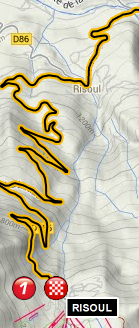I've re-ordered your post for convenience:
Merckx index said:
And yet as the post just preceding yours points out, the winning times in the four Tours preceding the EPO era were within seconds of each other. Hardly any variation at all. Nobody ever broke 33 minutes. And look at Hinault's times, the three times he rode it: 33:34; 34:07; 34:06. There are several other riders who rode it twice very consistently, but I don't know if they rode much more slowly in other years.
Merckx index said:
So two things to explain here. First, why, if there is so much potential variation due to weather, were the winning times, and also the following times, so consistent for four straight races involving that stage? It seems to me this fact virtually demands than any wind conditions be cancelled out by the twists and turns of the stage.
It's a mathematical certainty that coincidences will occur, if you look at enough data you'll find them. It's called the improbability principle.
I'm not saying that these were coincidences, but it's entirely possible that both the weather conditions and form of those riders on those days was the same. Or it might be form was somewhat different but conditions were different and happened to net such things out so that ascent times were the same. e.g. 5% more power but worse conditions. It happens.
Merckx index said:
The drop in winning times to 29-30 minutes is unquestionably the result of EPO. I don't think anyone can dispute that. But as SB notes, it is really curious that Nibali/Peraud just did times that would have decimated the field prior to EPO.
And that's an example of a trend change, which is probably a combination of several global things, e.g. EPO, better quality road surface, lighter equipment and quite possibly better prepared riders. There can also be some natural variation that happened to coincide and amplifies the change or indeed suppressed the actual change (i.e if those years happened to have crap conditions then they may well have gone even faster).
I note that the "EPO era" times had quite a bit more variation.
Merckx index said:
Second, how can clean riders today be so much better than those of the past? Is this supposed to be evidence of clean racers eventually doing better than dopers of the past, as heralded by JV and others?
By VAM, the older winning times were about 5.50 watts/kg., and I believe this is about what riders of that period also did on other climbs, allowing for differences in the length of the climb. But according to most thinking today, a non-doped rider can greatly exceed that. The curves at your site imply that large numbers of riders probably have the physical potential to do better than 6.0. That's not to say they will, of course, but that certainly underlies the view that power outputs in that range could be clean. So why are riders today so much faster than those of the past? There may be some technological improvements, but I believe we discussed on another thread these, and came to the conclusion that bike weights, e.g., could not account for the difference.
We can only imagine there could be a range of possible reasons:
better training and more targeted preparation
better nutrition and diet
better training approaches overall, as well as support
better roads
lighter bikes
better aerodynamics
better talent pool to choose from
better doping
etc
I think attributing an overall improvement in athletic performance over generations to one cause and one cause only (e.g. doping) is foolish.
Equally I think that these things don't exclude the possibility that doping is also a factor in today's performances. We already know it has been.
IOW what I'm saying is we don't really know.
BTW - I just watched a video of the 2005 stage up Pla d'Adet and there was a headwind based on the flags I could see. The flags were moving more than those I saw for yesterdays tailwind.
So this year's time with a slight tailwind was about the same as the 2005 time with a headwind. Who knows but that could easily be a 0.5W/kg difference for the same time. Or not.
Massive difference between the crowds then and now. Far fewer now.






